2024
|
 | Šamajová, Veronika; Marešová, Jana; Majdák, Andrej; Jakuš, Rastislav; Blaženec, Miroslav The spruce bark volatiles and internal phloem chemical profiles after the forest gap formation: the annual course Journal Article Folia Oecologica, 51 (2), pp. 165–174, 2024, ISSN: 1338-7014. Abstract | Links | BibTeX @article{_amajov__2024,
title = {The spruce bark volatiles and internal phloem chemical profiles after the forest gap formation: the annual course},
author = {Veronika Šamajová and Jana Marešová and Andrej Majdák and Rastislav Jakuš and Miroslav Blaženec},
url = {http://ife.sk/wp-content/uploads/2020/09/foecol-2024-0016.pdf},
doi = {10.2478/foecol-2024-0016},
issn = {1338-7014},
year = {2024},
date = {2024-07-01},
journal = {Folia Oecologica},
volume = {51},
number = {2},
pages = {165–174},
publisher = {Walter de Gruyter GmbH},
abstract = {Our study explores the impact of sudden gap formation on the bark volatile and internal chemical profiles of Norway spruce trees during the initial dry year of research plot 2018 following gap formation. We investigated the annual variation in two main physiological traits of Norway spruce trees at the forest edge (FE) and in the forest interior (FI): bark monoterpene (MT) emission spectra and internal phloem MT composition. Given that gap formation increases the solar radiation dose and temperature for trees at the forest edge, we hypothesized that the concentrations of airborne terpenes released from the tree bark and internal phloem terpenes will increase as a consequence of induced tree defenses. Our findings demonstrate significant increases in both airborne terpene concentrations and internal terpene composition in trees at the forest edge compared to the control trees in the forest interior. This study provides novel insights into the annual dynamics of bark monoterpenes following forest edge establishment and underscores the physiological changes experienced by trees in response to the gap formation.},
keywords = {},
pubstate = {published},
tppubtype = {article}
}
Our study explores the impact of sudden gap formation on the bark volatile and internal chemical profiles of Norway spruce trees during the initial dry year of research plot 2018 following gap formation. We investigated the annual variation in two main physiological traits of Norway spruce trees at the forest edge (FE) and in the forest interior (FI): bark monoterpene (MT) emission spectra and internal phloem MT composition. Given that gap formation increases the solar radiation dose and temperature for trees at the forest edge, we hypothesized that the concentrations of airborne terpenes released from the tree bark and internal phloem terpenes will increase as a consequence of induced tree defenses. Our findings demonstrate significant increases in both airborne terpene concentrations and internal terpene composition in trees at the forest edge compared to the control trees in the forest interior. This study provides novel insights into the annual dynamics of bark monoterpenes following forest edge establishment and underscores the physiological changes experienced by trees in response to the gap formation. |
2022
|
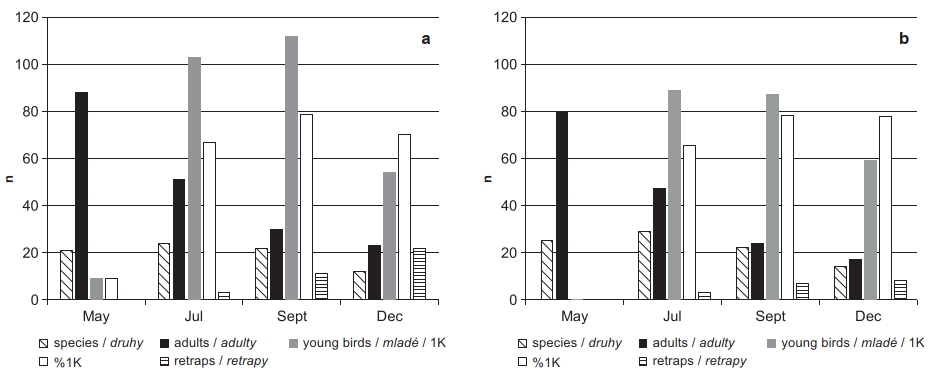 | Krištín, Anton; Blaženec, Miroslav; Kaňuch, Peter Seasonal changes of bird assemblages in a small urban wetland revealed by mist-netting Journal Article Tichodroma, (34), pp. 19–28, 2022. Abstract | Links | BibTeX @article{Krištín2022b,
title = {Seasonal changes of bird assemblages in a small urban wetland revealed by mist-netting},
author = {Anton Krištín and Miroslav Blaženec and Peter Kaňuch},
doi = {10.31577/tichodroma.2022.34.3},
year = {2022},
date = {2022-12-27},
journal = {Tichodroma},
number = {34},
pages = {19–28},
abstract = {Seasonal differences of bird assemblages were studied using mist-netting method during four seasons (May, July, September, and December) in two years (2014 and 2021) in a secondary wetland habitat (7 mist-nets in willow grove, reed, and scrubland) in Zvolen town, central Slovakia. Altogether 54 species and 876 individuals of birds were captured during 24 days of eight trapping sessions (in 84 m of mist-nets at 7.3 ha study plot). The highest number of mist-netted species and individuals was found in July (36 species, 290 individuals), the lowest was in December (16 species, 153 individuals), pooled for both years. The most abundant species were breeding species Sylvia atricapilla, Parus major, Cyanistes caeruleus and Turdus merula. The characteristic reedbed birds included four Acrocephalus species, Locustella luscinioides, Emberiza schoeniclus, and scrubland species Luscinia megarhynchos, Sylvia communis and Remiz pendulinus. Seasonal differences in species number and abundance are discussed. Regular wintering was found in migratory species Prunella modularis and Erithacus rubecula north of the known winter quarters of their central European breeding populations. The site fidelity and between-season retraps were confirmed in 10 species and 54 individuals (18.5% of all mist-netted species and 6.2% of all individuals). Based on retrapped individuals, the resident species P. major, C. caeruleus, Aegithalos caudatus and T. merula were the most faithful to the site, whereas inter-seasonal retraps of migratory species were rare (e. g. Sylvia atricapilla, Luscinia megarhynchos and Phylloscopus collybita).},
keywords = {},
pubstate = {published},
tppubtype = {article}
}
Seasonal differences of bird assemblages were studied using mist-netting method during four seasons (May, July, September, and December) in two years (2014 and 2021) in a secondary wetland habitat (7 mist-nets in willow grove, reed, and scrubland) in Zvolen town, central Slovakia. Altogether 54 species and 876 individuals of birds were captured during 24 days of eight trapping sessions (in 84 m of mist-nets at 7.3 ha study plot). The highest number of mist-netted species and individuals was found in July (36 species, 290 individuals), the lowest was in December (16 species, 153 individuals), pooled for both years. The most abundant species were breeding species Sylvia atricapilla, Parus major, Cyanistes caeruleus and Turdus merula. The characteristic reedbed birds included four Acrocephalus species, Locustella luscinioides, Emberiza schoeniclus, and scrubland species Luscinia megarhynchos, Sylvia communis and Remiz pendulinus. Seasonal differences in species number and abundance are discussed. Regular wintering was found in migratory species Prunella modularis and Erithacus rubecula north of the known winter quarters of their central European breeding populations. The site fidelity and between-season retraps were confirmed in 10 species and 54 individuals (18.5% of all mist-netted species and 6.2% of all individuals). Based on retrapped individuals, the resident species P. major, C. caeruleus, Aegithalos caudatus and T. merula were the most faithful to the site, whereas inter-seasonal retraps of migratory species were rare (e. g. Sylvia atricapilla, Luscinia megarhynchos and Phylloscopus collybita). |
 | Potterf, Mária; Svitok, Marek; Mezei, Pavel; Jarčuška, Benjamín; Jakuš, Rastislav; Blaženec, Miroslav; Hlásny, Tomáš Contrasting Norway spruce disturbance dynamics in managed forests and strict forest reserves in Slovakia Journal Article Forestry, 96 (3), pp. 387–398, 2022, ISSN: 1464-3626. Links | BibTeX @article{Potterf_2022,
title = {Contrasting Norway spruce disturbance dynamics in managed forests and strict forest reserves in Slovakia},
author = {Mária Potterf and Marek Svitok and Pavel Mezei and Benjamín Jarčuška and Rastislav Jakuš and Miroslav Blaženec and Tomáš Hlásny},
editor = {Dominik Thom},
url = {http://dx.doi.org/10.1093/forestry/cpac045},
doi = {10.1093/forestry/cpac045},
issn = {1464-3626},
year = {2022},
date = {2022-11-01},
journal = {Forestry},
volume = {96},
number = {3},
pages = {387–398},
publisher = {Oxford University Press (OUP)},
keywords = {},
pubstate = {published},
tppubtype = {article}
}
|
 | Jakuš, Rastislav; Modlinger, Roman; Kašpar, Jaroslav; Majdák, Andrej; Blaženec, Miroslav; Korolyova, Nataliya; Jirošová, Anna; Schlyter, Fredrik Testing the Efficiency of the Push-and-Pull Strategy during Severe Ips typographus Outbreak and Extreme Drought in Norway Spruce Stands Journal Article Forests, 13 (12), pp. 2175, 2022, ISSN: 1999-4907. Links | BibTeX @article{Jaku__2022,
title = {Testing the Efficiency of the Push-and-Pull Strategy during Severe Ips typographus Outbreak and Extreme Drought in Norway Spruce Stands},
author = {Rastislav Jakuš and Roman Modlinger and Jaroslav Kašpar and Andrej Majdák and Miroslav Blaženec and Nataliya Korolyova and Anna Jirošová and Fredrik Schlyter},
url = {http://dx.doi.org/10.3390/f13122175},
doi = {10.3390/f13122175},
issn = {1999-4907},
year = {2022},
date = {2022-01-01},
journal = {Forests},
volume = {13},
number = {12},
pages = {2175},
publisher = {MDPI AG},
keywords = {},
pubstate = {published},
tppubtype = {article}
}
|
 | Jirošová, Anna; Kalinová, Blanka; Modlinger, Roman; Jakuš, Rastislav; Unelius, Rikard C; Blaženec, Miroslav; Schlyter, Fredrik Anti‐attractant activity of (+)‐trans‐4‐thujanol for Eurasian spruce bark beetle Ips typographus: Novel potency for females Journal Article Pest Management Science, 78 (5), pp. 1992–1999, 2022, ISSN: 1526-4998. Links | BibTeX @article{Jiro_ov__2022,
title = {Anti‐attractant activity of (+)‐trans‐4‐thujanol for Eurasian spruce bark beetle Ips typographus: Novel potency for females},
author = {Anna Jirošová and Blanka Kalinová and Roman Modlinger and Rastislav Jakuš and Rikard C Unelius and Miroslav Blaženec and Fredrik Schlyter},
url = {http://dx.doi.org/10.1002/ps.6819},
doi = {10.1002/ps.6819},
issn = {1526-4998},
year = {2022},
date = {2022-01-01},
journal = {Pest Management Science},
volume = {78},
number = {5},
pages = {1992–1999},
publisher = {Wiley},
keywords = {},
pubstate = {published},
tppubtype = {article}
}
|
 | Marešová, Jana; Húdoková, Hana; Sarvašová, Lenka; Fleischer, Peter; Ditmarová, Ľubica; Blaženec, Miroslav; Jamnická, Gabriela Dynamics of internal isoprenoid metabolites in young Picea abies (Norway spruce) shoots during drought stress conditions in springtime Journal Article Phytochemistry, 203 , pp. 113414, 2022, ISSN: 0031-9422. Links | BibTeX @article{Mare_ov__2022,
title = {Dynamics of internal isoprenoid metabolites in young Picea abies (Norway spruce) shoots during drought stress conditions in springtime},
author = {Jana Marešová and Hana Húdoková and Lenka Sarvašová and Peter Fleischer and Ľubica Ditmarová and Miroslav Blaženec and Gabriela Jamnická},
url = {http://dx.doi.org/10.1016/j.phytochem.2022.113414},
doi = {10.1016/j.phytochem.2022.113414},
issn = {0031-9422},
year = {2022},
date = {2022-01-01},
journal = {Phytochemistry},
volume = {203},
pages = {113414},
publisher = {Elsevier BV},
keywords = {},
pubstate = {published},
tppubtype = {article}
}
|
 | Salomón, Roberto L; Peters, Richard L; Zweifel, Roman; Sass-Klaassen, Ute G W; Stegehuis, Annemiek I; Smiljanic, Marko; Poyatos, Rafael; Babst, Flurin; Cienciala, Emil; Fonti, Patrick; Lerink, Bas J W; Lindner, Marcus; Martinez-Vilalta, Jordi; Mencuccini, Maurizio; Nabuurs, Gert-Jan; van der Maaten, Ernst; von Arx, Georg; Bär, Andreas; Akhmetzyanov, Linar; Balanzategui, Daniel; Bellan, Michal; Bendix, Jörg; Berveiller, Daniel; Blaženec, Miroslav; Čada, Vojtěch; Carraro, Vinicio; Cecchini, Sébastien; Chan, Tommy; Conedera, Marco; Delpierre, Nicolas; Delzon, Sylvain; Ditmarová, Ľubica; Dolezal, Jiri; Dufrêne, Eric; Edvardsson, Johannes; Ehekircher, Stefan; Forner, Alicia; Frouz, Jan; Ganthaler, Andrea; Gryc, Vladimír; Güney, Aylin; Heinrich, Ingo; Hentschel, Rainer; Janda, Pavel; Ježík, Marek; Kahle, Hans-Peter; Knüsel, Simon; Krejza, Jan; Kuberski, Łukasz; Kučera, Jiří; Lebourgeois, François; Mikoláš, Martin; Matula, Radim; Mayr, Stefan; Oberhuber, Walter; Obojes, Nikolaus; Osborne, Bruce; Paljakka, Teemu; Plichta, Roman; Rabbel, Inken; Rathgeber, Cyrille B K; Salmon, Yann; Saunders, Matthew; Scharnweber, Tobias; Sitková, Zuzana; Stangler, Dominik Florian; Stereńczak, Krzysztof; Stojanović, Marko; Střelcová, Katarína; Světlík, Jan; Svoboda, Miroslav; Tobin, Brian; Trotsiuk, Volodymyr; Urban, Josef; Valladares, Fernando; Vavrčík, Hanuš; Vejpustková, Monika; Walthert, Lorenz; Wilmking, Martin; Zin, Ewa; Zou, Junliang; Steppe, Kathy The 2018 European heatwave led to stem dehydration but not to consistent growth reductions in forests Journal Article Nature Communications, 13 (1), 2022, ISSN: 2041-1723. Links | BibTeX @article{Salom_n_2022,
title = {The 2018 European heatwave led to stem dehydration but not to consistent growth reductions in forests},
author = {Roberto L Salomón and Richard L Peters and Roman Zweifel and Ute G W Sass-Klaassen and Annemiek I Stegehuis and Marko Smiljanic and Rafael Poyatos and Flurin Babst and Emil Cienciala and Patrick Fonti and Bas J W Lerink and Marcus Lindner and Jordi Martinez-Vilalta and Maurizio Mencuccini and Gert-Jan Nabuurs and Ernst van der Maaten and Georg von Arx and Andreas Bär and Linar Akhmetzyanov and Daniel Balanzategui and Michal Bellan and Jörg Bendix and Daniel Berveiller and Miroslav Blaženec and Vojtěch Čada and Vinicio Carraro and Sébastien Cecchini and Tommy Chan and Marco Conedera and Nicolas Delpierre and Sylvain Delzon and Ľubica Ditmarová and Jiri Dolezal and Eric Dufrêne and Johannes Edvardsson and Stefan Ehekircher and Alicia Forner and Jan Frouz and Andrea Ganthaler and Vladimír Gryc and Aylin Güney and Ingo Heinrich and Rainer Hentschel and Pavel Janda and Marek Ježík and Hans-Peter Kahle and Simon Knüsel and Jan Krejza and Łukasz Kuberski and Jiří Kučera and François Lebourgeois and Martin Mikoláš and Radim Matula and Stefan Mayr and Walter Oberhuber and Nikolaus Obojes and Bruce Osborne and Teemu Paljakka and Roman Plichta and Inken Rabbel and Cyrille B K Rathgeber and Yann Salmon and Matthew Saunders and Tobias Scharnweber and Zuzana Sitková and Dominik Florian Stangler and Krzysztof Stereńczak and Marko Stojanović and Katarína Střelcová and Jan Světlík and Miroslav Svoboda and Brian Tobin and Volodymyr Trotsiuk and Josef Urban and Fernando Valladares and Hanuš Vavrčík and Monika Vejpustková and Lorenz Walthert and Martin Wilmking and Ewa Zin and Junliang Zou and Kathy Steppe},
url = {http://dx.doi.org/10.1038/s41467-021-27579-9},
doi = {10.1038/s41467-021-27579-9},
issn = {2041-1723},
year = {2022},
date = {2022-01-01},
journal = {Nature Communications},
volume = {13},
number = {1},
publisher = {Springer Science and Business Media LLC},
keywords = {},
pubstate = {published},
tppubtype = {article}
}
|
2021
|
 | Ježík, Marek; Blaženec, Miroslav; Mezei, Pavel; Sedmáková, Denisa; Sedmák, Róbert; Fleischer, Peter; Fleischer, Peter; Bošeľa, Michal; Kurjak, Daniel; Střelcová, Katarína; Ditmarová, Ľubica Influence of weather and day length on intra-seasonal growth of Norway spruce (Picea abies) and European beech (Fagus sylvatica) in a natural montane forest Journal Article Canadian Journal of Forest Research, 51 (12), pp. 1799–1810, 2021, ISSN: 1208-6037. Links | BibTeX @article{Je_k_2021,
title = {Influence of weather and day length on intra-seasonal growth of Norway spruce (Picea abies) and European beech (Fagus sylvatica) in a natural montane forest},
author = {Marek Ježík and Miroslav Blaženec and Pavel Mezei and Denisa Sedmáková and Róbert Sedmák and Peter Fleischer and Peter Fleischer and Michal Bošeľa and Daniel Kurjak and Katarína Střelcová and Ľubica Ditmarová},
url = {http://dx.doi.org/10.1139/cjfr-2020-0067},
doi = {10.1139/cjfr-2020-0067},
issn = {1208-6037},
year = {2021},
date = {2021-12-01},
journal = {Canadian Journal of Forest Research},
volume = {51},
number = {12},
pages = {1799–1810},
publisher = {Canadian Science Publishing},
keywords = {},
pubstate = {published},
tppubtype = {article}
}
|
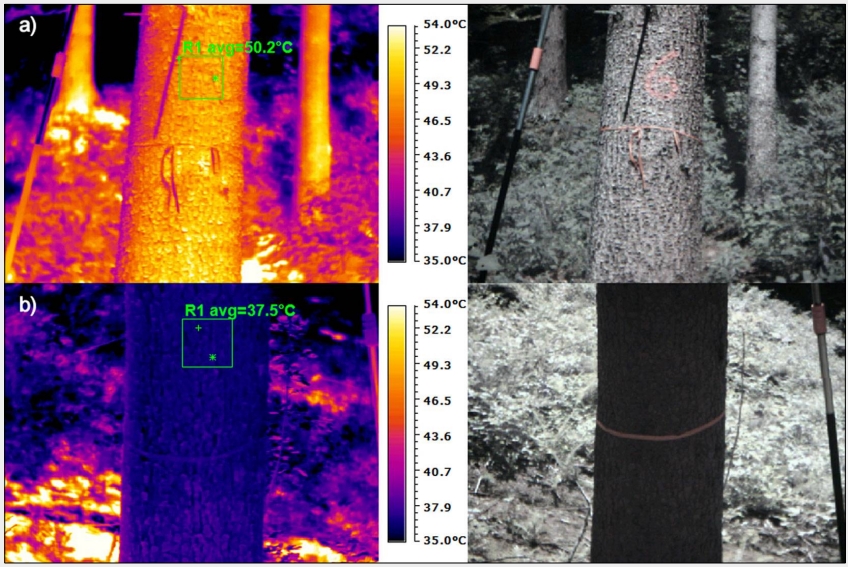 | Majdák, Andrej; Jakuš, Rastislav; Blaženec, Miroslav Determination of differences in temperature regimes on healthy and bark-beetle colonised spruce trees using a handheld thermal camera Journal Article iFOREST, 14 , pp. 203-211, 2021, ISSN: 1971-7458. Abstract | Links | BibTeX @article{Majdák2021,
title = {Determination of differences in temperature regimes on healthy and bark-beetle colonised spruce trees using a handheld thermal camera},
author = {Andrej Majdák and Rastislav Jakuš and Miroslav Blaženec},
doi = {https://doi.org/10.3832/ifor3531-014},
issn = {1971-7458},
year = {2021},
date = {2021-05-02},
journal = {iFOREST},
volume = {14},
pages = {203-211},
abstract = {In this study, we compared the daily temperature regimes of healthy uninfected trees in the interior of a forest stand and at the fresh forest edge with infested trees at the forest edge in an area affected by a bark beetle outbreak. We estimated the potential of a handheld thermal camera for early identification of bark-beetle infested trees. We show that infested trees have significantly higher trunk temperatures than uninfested trees, which is more visible on the shine side of the trunk, and we report the differences in temperature between the shine and shadow sides. The differences are more noticeable on a warm, bright, and sunny day than on cold and cloudy day. The different intensity of solar radiation does not affect the distinction between infested and uninfested trees. The handheld thermal camera shows potential for identifying bark-beetle infested trees by scanning tree trunks on bright sunny days.},
keywords = {},
pubstate = {published},
tppubtype = {article}
}
In this study, we compared the daily temperature regimes of healthy uninfected trees in the interior of a forest stand and at the fresh forest edge with infested trees at the forest edge in an area affected by a bark beetle outbreak. We estimated the potential of a handheld thermal camera for early identification of bark-beetle infested trees. We show that infested trees have significantly higher trunk temperatures than uninfested trees, which is more visible on the shine side of the trunk, and we report the differences in temperature between the shine and shadow sides. The differences are more noticeable on a warm, bright, and sunny day than on cold and cloudy day. The different intensity of solar radiation does not affect the distinction between infested and uninfested trees. The handheld thermal camera shows potential for identifying bark-beetle infested trees by scanning tree trunks on bright sunny days. |
 | Koreň, Milan; Jakuš, Rastislav; Zápotocký, Martin; Barka, Ivan; Holuša, Jaroslav; Ďuračiová, Renata; Blaženec, Miroslav Assessment of Machine Learning Algorithms for Modeling the Spatial Distribution of Bark Beetle Infestation Journal Article Forests, 12 (4), pp. 395, 2021, ISSN: 1999-4907. Links | BibTeX @article{Kore__2021,
title = {Assessment of Machine Learning Algorithms for Modeling the Spatial Distribution of Bark Beetle Infestation},
author = {Milan Koreň and Rastislav Jakuš and Martin Zápotocký and Ivan Barka and Jaroslav Holuša and Renata Ďuračiová and Miroslav Blaženec},
url = {http://dx.doi.org/10.3390/f12040395},
doi = {10.3390/f12040395},
issn = {1999-4907},
year = {2021},
date = {2021-01-01},
journal = {Forests},
volume = {12},
number = {4},
pages = {395},
publisher = {MDPI AG},
keywords = {},
pubstate = {published},
tppubtype = {article}
}
|
2020
|
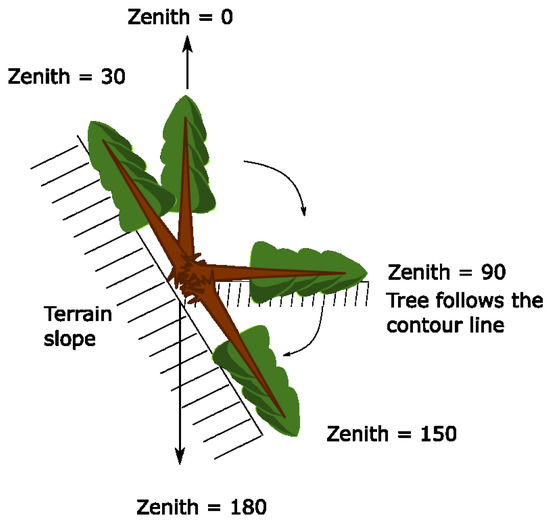 | Hroššo, Branislav; Mezei, Pavel; Potterf, Mária; Majdák, Andrej; Blaženec, Miroslav; Korolyova, Nataliya; Jakuš, Rastislav Drivers of Spruce Bark Beetle (Ips typographus) Infestations on Downed Trees after Severe Windthrow Journal Article Forests, 11 , 2020, ISSN: 1999-4907. Abstract | Links | BibTeX @article{Hroššo2020,
title = {Drivers of Spruce Bark Beetle (\textit{Ips typographus}) Infestations on Downed Trees after Severe Windthrow},
author = {Branislav Hroššo and Pavel Mezei and Mária Potterf and Andrej Majdák and Miroslav Blaženec and Nataliya Korolyova and Rastislav Jakuš},
doi = {10.3390/f11121290},
issn = {1999-4907},
year = {2020},
date = {2020-11-30},
journal = {Forests},
volume = {11},
abstract = {Research Highlights: Bark beetles are important agents of disturbance regimes in temperate forests, and specifically in a connected wind-bark beetle disturbance system. Large-scale windthrows trigger population growth of the European spruce bark beetle (Ips typographus L.) from endemic to epidemic levels, thereby allowing the killing of Norway spruce trees over several consecutive years. Background and Objectives: There is a lack of evidence to differentiate how outbreaks are promoted by the effects of environmental variables versus beetle preferences of trees from endemic to outbreak. However, little is known about how individual downed-tree characteristics and local conditions such as tree orientation and solar radiation affect beetle colonization of downed trees. Materials and Methods: To answer this question, we investigated the infestation rates and determined tree death categories (uprooted, broken, and stump) in wind-damaged areas in Western Tatra Mts. in Carpathians (Slovakia) from 2014–2016, following a windthrow in May 2014. In total, we investigated 225 trees over eight transects. For every tree, we measured its morphological (tree height, crown characteristics), environmental (solar radiation, terrain conditions, trunk zenith), temporal (time since wind damage), and beetle infestation (presence, location of attack, bark desiccation) parameters. We applied Generalized Additive Mixed Models (GAMM) to unravel the main drivers of I. typographus infestations. Results: Over the first year, beetles preferred to attack broken trees and sun-exposed trunk sides over uprooted trees; the infestation on shaded sides started in the second year along with the infestation of uprooted trees with lower desiccation rates. We found that time since wind damage, stem length, and incident solar radiation increased the probability of beetle infestation, although both solar radiation and trunk zenith exhibited nonlinear variability. Our novel variable trunk zenith appeared to be an important predictor of bark beetle infestation probability. We conclude that trunk zenith as a simple measure defining the position of downed trees over the terrain can anticipate beetle infestation. Conclusions: Our findings contribute to understanding of the bark beetle’s preferences to colonize windthrown trees in the initial years after the primary wind damage. Further, our findings can help to identify trees that are most susceptible to beetle infestation and to prioritize management actions to control beetle population while maintaining biodiversity.},
keywords = {},
pubstate = {published},
tppubtype = {article}
}
Research Highlights: Bark beetles are important agents of disturbance regimes in temperate forests, and specifically in a connected wind-bark beetle disturbance system. Large-scale windthrows trigger population growth of the European spruce bark beetle (Ips typographus L.) from endemic to epidemic levels, thereby allowing the killing of Norway spruce trees over several consecutive years. Background and Objectives: There is a lack of evidence to differentiate how outbreaks are promoted by the effects of environmental variables versus beetle preferences of trees from endemic to outbreak. However, little is known about how individual downed-tree characteristics and local conditions such as tree orientation and solar radiation affect beetle colonization of downed trees. Materials and Methods: To answer this question, we investigated the infestation rates and determined tree death categories (uprooted, broken, and stump) in wind-damaged areas in Western Tatra Mts. in Carpathians (Slovakia) from 2014–2016, following a windthrow in May 2014. In total, we investigated 225 trees over eight transects. For every tree, we measured its morphological (tree height, crown characteristics), environmental (solar radiation, terrain conditions, trunk zenith), temporal (time since wind damage), and beetle infestation (presence, location of attack, bark desiccation) parameters. We applied Generalized Additive Mixed Models (GAMM) to unravel the main drivers of I. typographus infestations. Results: Over the first year, beetles preferred to attack broken trees and sun-exposed trunk sides over uprooted trees; the infestation on shaded sides started in the second year along with the infestation of uprooted trees with lower desiccation rates. We found that time since wind damage, stem length, and incident solar radiation increased the probability of beetle infestation, although both solar radiation and trunk zenith exhibited nonlinear variability. Our novel variable trunk zenith appeared to be an important predictor of bark beetle infestation probability. We conclude that trunk zenith as a simple measure defining the position of downed trees over the terrain can anticipate beetle infestation. Conclusions: Our findings contribute to understanding of the bark beetle’s preferences to colonize windthrown trees in the initial years after the primary wind damage. Further, our findings can help to identify trees that are most susceptible to beetle infestation and to prioritize management actions to control beetle population while maintaining biodiversity. |
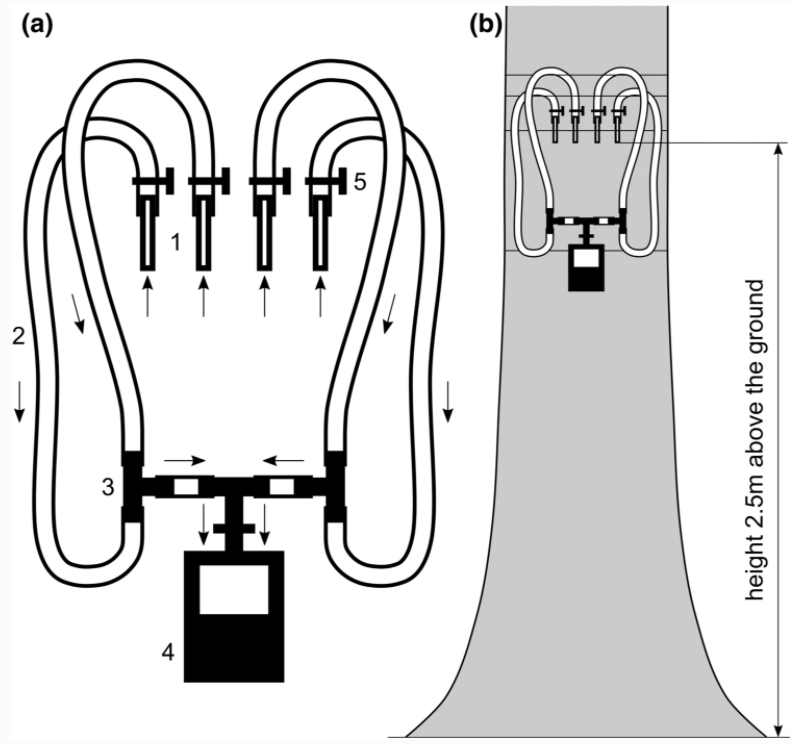 | Marešová, Jana; Majdák, Andrej; Jakuš, Rastislav; Hradecký, Jaromír; Kalinová, Blanka; Blaženec, Miroslav The short-term effect of sudden gap creation on tree temperature and volatile composition profiles in a Norway spruce stand Journal Article Trees-Structure and Function, 34 (6), pp. 1397–1409, 2020, ISSN: 0931-1890. Abstract | Links | BibTeX @article{Marešová2020,
title = {The short-term effect of sudden gap creation on tree temperature and volatile composition profiles in a Norway spruce stand},
author = {Jana Marešová and Andrej Majdák and Rastislav Jakuš and Jaromír Hradecký and Blanka Kalinová and Miroslav Blaženec},
doi = {10.1007/s00468-020-02010-w},
issn = {0931-1890},
year = {2020},
date = {2020-08-05},
journal = {Trees-Structure and Function},
volume = {34},
number = {6},
pages = {1397–1409},
abstract = {Spruce bark beetles are likely to attack trees that are at newly opened forest edges after wind disturbance due to higher temperatures and higher emission of primary attractants. The mechanisms behind these phenomena are still not fully known. We investigated how sudden gap creation affects tree physiology parameters related to induced defence processes in Norway spruce trees 2 months after the disturbance driven gap formation. We hypothesized that the sudden sun exposure of mature spruce trees would increase: (1) bark and crown temperatures, (2) sap flow rates, and (3) the phloem and airborne concentration of terpenes. Using a terrestrial and airborne thermal camera, sap flow sensors, and chromatography, we confirmed that trees at the forest edge had significantly higher (1) mean tree crown temperature, (2) mean sap flow rates (2-fold higher) and (3) airborne concentration of α-pinene (αP, 12.2-fold higher) and β-pinene (βP, 7.9-fold higher) close to the bark. We observed a significant positive correlation (R2 = 0.77) between the measured sap flow rates and terpene concentrations in airborne samples. Bark temperatures were not significant. In the phloem samples, analyzed by GC–MS, αP and βP predominated over monoterpenes 3-carene, myrcene, limonene, 1.8-cineole, and bornyl acetate. GC × GC–TOF–MS analysis of phloem showed a higher relative abundance of resin acid methyl esters in the forest interior trees and higher relative abundances of dehydro-p-cymene in the trees at the forest edge. Our findings are discussed in the context of the enhanced predisposition of trees at the newly formed forest edge to bark beetles attack.},
keywords = {},
pubstate = {published},
tppubtype = {article}
}
Spruce bark beetles are likely to attack trees that are at newly opened forest edges after wind disturbance due to higher temperatures and higher emission of primary attractants. The mechanisms behind these phenomena are still not fully known. We investigated how sudden gap creation affects tree physiology parameters related to induced defence processes in Norway spruce trees 2 months after the disturbance driven gap formation. We hypothesized that the sudden sun exposure of mature spruce trees would increase: (1) bark and crown temperatures, (2) sap flow rates, and (3) the phloem and airborne concentration of terpenes. Using a terrestrial and airborne thermal camera, sap flow sensors, and chromatography, we confirmed that trees at the forest edge had significantly higher (1) mean tree crown temperature, (2) mean sap flow rates (2-fold higher) and (3) airborne concentration of α-pinene (αP, 12.2-fold higher) and β-pinene (βP, 7.9-fold higher) close to the bark. We observed a significant positive correlation (R2 = 0.77) between the measured sap flow rates and terpene concentrations in airborne samples. Bark temperatures were not significant. In the phloem samples, analyzed by GC–MS, αP and βP predominated over monoterpenes 3-carene, myrcene, limonene, 1.8-cineole, and bornyl acetate. GC × GC–TOF–MS analysis of phloem showed a higher relative abundance of resin acid methyl esters in the forest interior trees and higher relative abundances of dehydro-p-cymene in the trees at the forest edge. Our findings are discussed in the context of the enhanced predisposition of trees at the newly formed forest edge to bark beetles attack. |
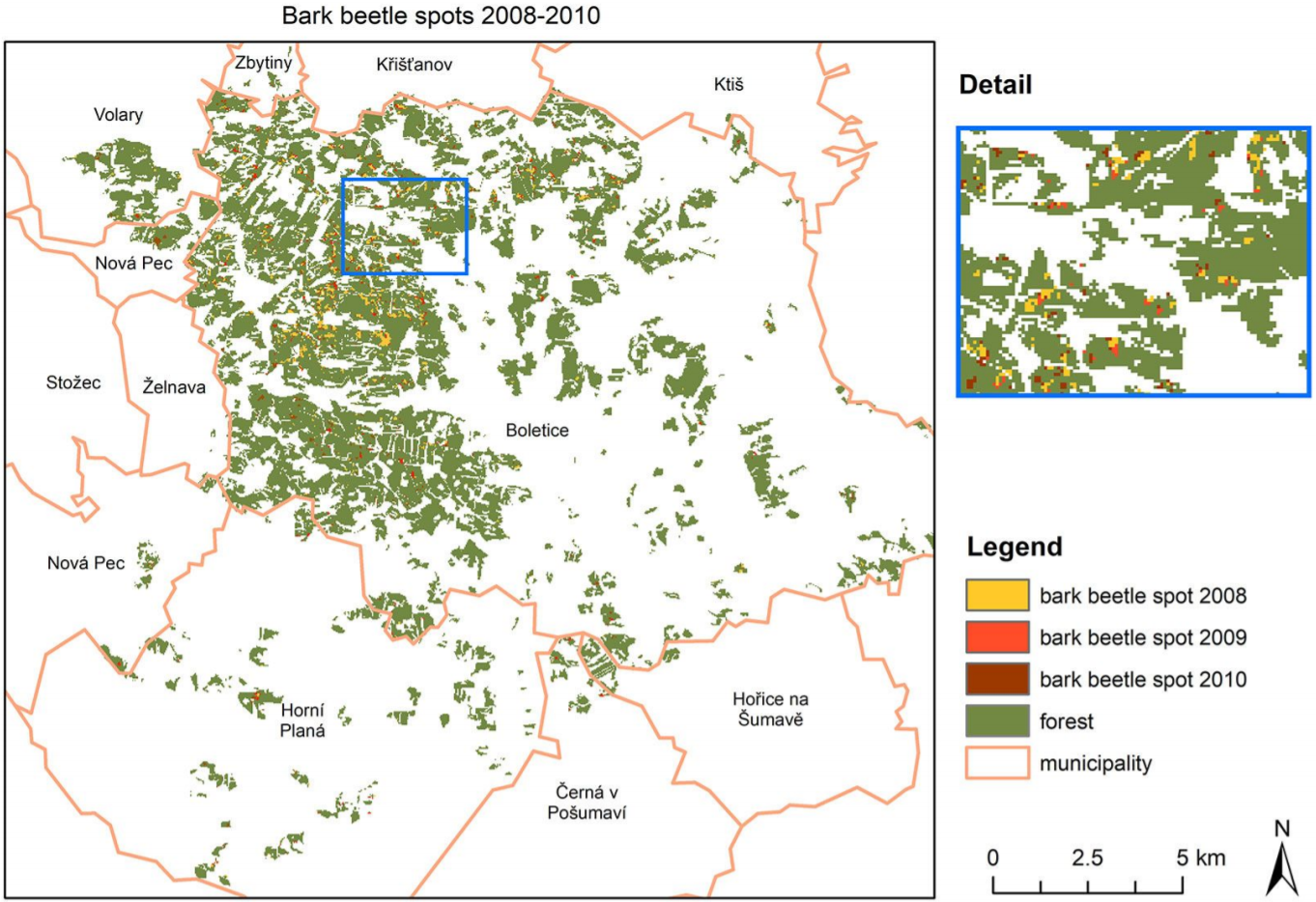 | Duračiová, Renata; Muňko, Milan; Barka, Ivan; Koreň, Milan; Resnerová, Karolina; Holuša, Jaroslav; Blaženec, Miroslav; Potterf, Mária; Jakuš, Rastislav A bark beetle infestation predictive model based on satellite data in the frame of decision support system TANABBO Journal Article iFOREST, 13 (3), pp. 215-223, 2020, ISSN: 1971-7458. Abstract | Links | BibTeX @article{Duračiová2020,
title = {A bark beetle infestation predictive model based on satellite data in the frame of decision support system TANABBO},
author = {Renata Duračiová and Milan Muňko and Ivan Barka and Milan Koreň and Karolina Resnerová and Jaroslav Holuša and Miroslav Blaženec and Mária Potterf and Rastislav Jakuš},
doi = {10.3832/ifor3271-013},
issn = {1971-7458},
year = {2020},
date = {2020-06-06},
journal = {iFOREST},
volume = {13},
number = {3},
pages = {215-223},
abstract = {The European spruce bark beetle Ips typographus L. causes significant economic losses in managed coniferous forests in Central and Northern Europe. New infestations either occur in previously undisturbed forest stands (i.e., spot initiation) or depend on proximity to previous years’ infestations (i.e., spot spreading). Early identification of newly infested trees over the forested landscape limits the effective control measures. Accurate forecasting of the spread of bark beetle infestation is crucial to plan efficient sanitation felling of infested trees and prevent further propagation of beetle-induced tree mortality. We created a predictive model of subsequent year spot initiation and spot spreading within the TANABBO decision support system. The algorithm combines open-access Landsat-based vegetation change time-series data, a digital terrain model, and forest stand characteristics. We validated predicted susceptibility to bark beetle attack (separately for spot initiation and spot spreading) against beetle infestations in managed forests in the Bohemian Forest in the Czech Republic (Central Europe) in yearly time steps from 2007 to 2010. The predictive models of susceptibility to bark beetle attack had a high degree of reliability (area under the ROC curve - AUC: 0.75-0.82). We conclude that spot initiation and spot spreading prediction modules included within the TANABBO model have the potential to help forest managers to plan sanitation felling in managed forests under pressure of bark beetle outbreak.},
keywords = {},
pubstate = {published},
tppubtype = {article}
}
The European spruce bark beetle Ips typographus L. causes significant economic losses in managed coniferous forests in Central and Northern Europe. New infestations either occur in previously undisturbed forest stands (i.e., spot initiation) or depend on proximity to previous years’ infestations (i.e., spot spreading). Early identification of newly infested trees over the forested landscape limits the effective control measures. Accurate forecasting of the spread of bark beetle infestation is crucial to plan efficient sanitation felling of infested trees and prevent further propagation of beetle-induced tree mortality. We created a predictive model of subsequent year spot initiation and spot spreading within the TANABBO decision support system. The algorithm combines open-access Landsat-based vegetation change time-series data, a digital terrain model, and forest stand characteristics. We validated predicted susceptibility to bark beetle attack (separately for spot initiation and spot spreading) against beetle infestations in managed forests in the Bohemian Forest in the Czech Republic (Central Europe) in yearly time steps from 2007 to 2010. The predictive models of susceptibility to bark beetle attack had a high degree of reliability (area under the ROC curve - AUC: 0.75-0.82). We conclude that spot initiation and spot spreading prediction modules included within the TANABBO model have the potential to help forest managers to plan sanitation felling in managed forests under pressure of bark beetle outbreak. |
2019
|
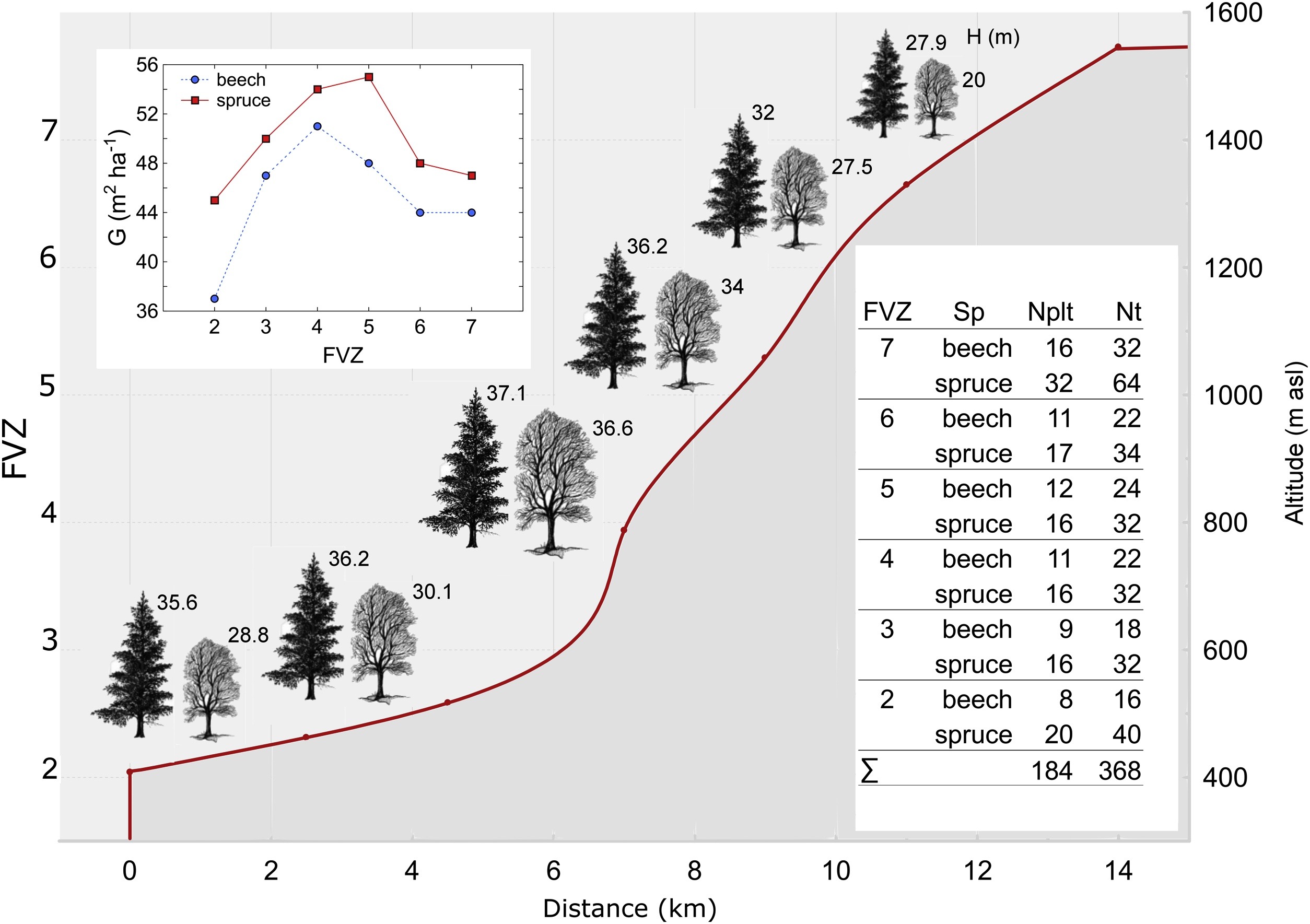 | Denisa Sedmáková Róbert Sedmák, Michal Bosela Marek Ježík Miroslav Blaženec Tomáš Hlásny Róbert Marušák Growth-climate responses indicate shifts in the competitive ability of European beech and Norway spruce under recent climate warming in East-Central Europe Journal Article Dendrochronologia, 54 , pp. 67-48, 2019, ISSN: 1125-7865. Abstract | Links | BibTeX @article{Sedmáková2019,
title = {Growth-climate responses indicate shifts in the competitive ability of European beech and Norway spruce under recent climate warming in East-Central Europe},
author = {Denisa Sedmáková, Róbert Sedmák, Michal Bosela, Marek Ježík, Miroslav Blaženec, Tomáš Hlásny, Róbert Marušák},
doi = {10.1016/j.dendro.2019.02.001},
issn = {1125-7865},
year = {2019},
date = {2019-04-01},
journal = {Dendrochronologia},
volume = {54},
pages = {67-48},
abstract = {Long-term changes in climate substantially affect the tree growth and species distribution in Europe. In the presented study, the radial growth of Fagus sylvatica (L.) and Picea abies ((L.) Karst.) has been studied along an altitudinal gradient covering six vegetation formations characteristic for sub-montane, montane and high-montane conditions of the western Carpathians. Tree growth responses to temperature and precipitation changes have been analysed based on the sample of increment cores and standard dendroclimatic methods in two time periods, the reference period 1961–1990 and the recent period 1991–2012. The growth responses of spruce and beech to recent changes in climate were similar up to high-montane zones, where the beech shows significantly larger improvements of radial increments in comparison to spruce. The growth responses were mainly temperature driven. In the sub-montane area, the increased effect of precipitation in the recent period was overridden by the negative effects of warming, and the alleviated temperature limitation had an evidently supportive effect on tree growth in montane and high-montane areas. In the near future, the warming will likely cause decline in radial increments of beech and spruce in sub-montane areas due to expected landscape drying. At the same time, the improved competitive ability of beech in the high-montane zones suggests a shift in the leading edge of beech distribution into higher altitudes in East-Central Europe.},
keywords = {},
pubstate = {published},
tppubtype = {article}
}
Long-term changes in climate substantially affect the tree growth and species distribution in Europe. In the presented study, the radial growth of Fagus sylvatica (L.) and Picea abies ((L.) Karst.) has been studied along an altitudinal gradient covering six vegetation formations characteristic for sub-montane, montane and high-montane conditions of the western Carpathians. Tree growth responses to temperature and precipitation changes have been analysed based on the sample of increment cores and standard dendroclimatic methods in two time periods, the reference period 1961–1990 and the recent period 1991–2012. The growth responses of spruce and beech to recent changes in climate were similar up to high-montane zones, where the beech shows significantly larger improvements of radial increments in comparison to spruce. The growth responses were mainly temperature driven. In the sub-montane area, the increased effect of precipitation in the recent period was overridden by the negative effects of warming, and the alleviated temperature limitation had an evidently supportive effect on tree growth in montane and high-montane areas. In the near future, the warming will likely cause decline in radial increments of beech and spruce in sub-montane areas due to expected landscape drying. At the same time, the improved competitive ability of beech in the high-montane zones suggests a shift in the leading edge of beech distribution into higher altitudes in East-Central Europe. |
2017
|
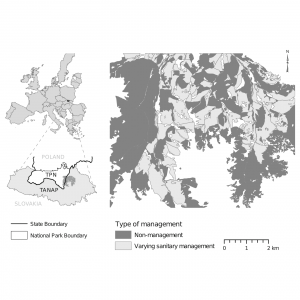 | Mezei, Pavel; Blaženec, Miroslav; Grodzki, Wojciech; Škvarenina, Jaroslav; Jakuš, Rastislav Influence of different forest protection strategies on spruce tree mortality during a bark beetle outbreak Journal Article Annals of Forest Science, 74 , 2017, ISSN: 1297-966X. Links | BibTeX @article{Mezei2017b,
title = {Influence of different forest protection strategies on spruce tree mortality during a bark beetle outbreak},
author = {Pavel Mezei and Miroslav Blaženec and Wojciech Grodzki and Jaroslav Škvarenina and Rastislav Jakuš},
url = {http://rdcu.be/wnGe},
doi = {doi.org/10.1007/s13595-017-0663-9},
issn = {1297-966X},
year = {2017},
date = {2017-09-27},
journal = {Annals of Forest Science},
volume = {74},
keywords = {},
pubstate = {published},
tppubtype = {article}
}
|
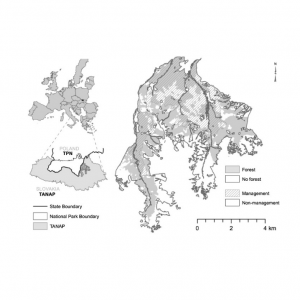 | Mezei, P; Jakuš, R; Pennerstorfer, J; Havašová, M; Škvarenina, J; Ferenčík, J; Slivinský, J; Bičárová, S; Bilčík, D; Blaženec, M; Netherer, S Storms, temperature maxima and the Eurasian spruce bark beetle Ips typographus — an infernal trio in Norway spruce forests of the Central European High Tatra Mountains Journal Article Agricultural and Forest Meteorology, 242 , pp. 85-95, 2017. Abstract | Links | BibTeX @article{Mezei2017,
title = {Storms, temperature maxima and the Eurasian spruce bark beetle \textit{Ips typographus} — an infernal trio in Norway spruce forests of the Central European High Tatra Mountains},
author = {P. Mezei and R. Jakuš and J. Pennerstorfer and M. Havašová and J. Škvarenina and J. Ferenčík and J. Slivinský and S. Bičárová and D. Bilčík and M. Blaženec and S. Netherer},
url = {http://ife.sk/wp-content/uploads/2016/10/Figure_4_20170406_2-pdf-300x192.jpghttp://www.sciencedirect.com/science/article/pii/S0168192317301326},
doi = {10.1016/j.agrformet.2017.04.004},
year = {2017},
date = {2017-04-10},
journal = { Agricultural and Forest Meteorology},
volume = {242},
pages = {85-95},
abstract = {Norway spruce forests (Picea abies Karst.) of the Carpathian High Tatra Mountains have been subject to unprecedented tree mortality caused by attacks of the Eurasian spruce bark beetle (Ips typographus L.) in recent decades. The outbreaks were preceded and accompanied by wind throw events and periods of increased seasonal temperature. We obtained climatic data and data on tree mortality due to storm throw and bark beetles by using a combination of direct dead tree inventory and remote sensing techniques, and examined annual tree loss change over a 26-year period in a forest district of the Slovak High Tatra National Park. In particular, we found that the combination of the previous year's maximum daily temperature sum, tree mortality caused by wind, and bark beetle-caused tree mortality best explained the annual tree loss change in nonlinear regression models. The number of trees infested by bark beetles clearly increased with maximum air temperature sums ranging from 2850 to 3150 ° days, but declined below or above this thermal optimum. Annual tree mortality clearly increased subsequent to years associated with seasonal temperature sums allowing for the development of sister broods. Given consistently favourable future climatic conditions for development of I. typographus populations in the study area, a possible shift from the now predominantly uni-voltine to multi-voltine bark beetle populations might increase attack pressure also at high elevation sites.},
keywords = {},
pubstate = {published},
tppubtype = {article}
}
Norway spruce forests (Picea abies Karst.) of the Carpathian High Tatra Mountains have been subject to unprecedented tree mortality caused by attacks of the Eurasian spruce bark beetle (Ips typographus L.) in recent decades. The outbreaks were preceded and accompanied by wind throw events and periods of increased seasonal temperature. We obtained climatic data and data on tree mortality due to storm throw and bark beetles by using a combination of direct dead tree inventory and remote sensing techniques, and examined annual tree loss change over a 26-year period in a forest district of the Slovak High Tatra National Park. In particular, we found that the combination of the previous year's maximum daily temperature sum, tree mortality caused by wind, and bark beetle-caused tree mortality best explained the annual tree loss change in nonlinear regression models. The number of trees infested by bark beetles clearly increased with maximum air temperature sums ranging from 2850 to 3150 ° days, but declined below or above this thermal optimum. Annual tree mortality clearly increased subsequent to years associated with seasonal temperature sums allowing for the development of sister broods. Given consistently favourable future climatic conditions for development of I. typographus populations in the study area, a possible shift from the now predominantly uni-voltine to multi-voltine bark beetle populations might increase attack pressure also at high elevation sites. |
![TANABBO II model pro hodnocení rizika napadení lesních porostů lýkožroutem smrkovým Ips typographus (L.) [Coleoptera: Curculionidae]](http://ife.sk/wp-content/uploads/2020/09/jakus_2007.png) | Jakuš, Rastislav; Blaženec, Miroslav; doc. Koreň, Mgr. Milan; Barka, Ivan; Lukášová, Karolina; Lubojacký, Jan; Holuša, Jaroslav TANABBO II model pro hodnocení rizika napadení lesních porostů lýkožroutem smrkovým Ips typographus (L.) [Coleoptera: Curculionidae] Book 1/2017, Výzkumný ústav lesního hospodářství a myslivosti, 2017. BibTeX @book{Jakuš2017,
title = {TANABBO II model pro hodnocení rizika napadení lesních porostů lýkožroutem smrkovým \textit{Ips typographus} (L.) [Coleoptera: Curculionidae]},
author = {Rastislav Jakuš and Miroslav Blaženec and doc. Mgr. Milan Koreň and Ivan Barka and Karolina Lukášová and Jan Lubojacký and Jaroslav Holuša},
year = {2017},
date = {2017-01-01},
publisher = {Výzkumný ústav lesního hospodářství a myslivosti},
edition = {1/2017},
keywords = {},
pubstate = {published},
tppubtype = {book}
}
|
2016
|
 | Chalachanová, Jana Faixová; Ďuračiová, Renata; Papčo, Juraj; Jakuš, Rastislav; Blaženec, Miroslav Integration of Heterogeneous Data in the Support of the Forest Protection: Structural Concept Journal Article Lecture Notes in Geoinformation and Cartography, pp. 387-405, 2016, ISSN: 1863-2246. Abstract | Links | BibTeX @article{Chalachanová2016,
title = {Integration of Heterogeneous Data in the Support of the Forest Protection: Structural Concept},
author = {Jana Faixová Chalachanová and Renata Ďuračiová and Juraj Papčo and Rastislav Jakuš and Miroslav Blaženec},
doi = {10.1007/978-3-319-45123-7_28},
issn = {1863-2246},
year = {2016},
date = {2016-10-15},
journal = {Lecture Notes in Geoinformation and Cartography},
pages = {387-405},
abstract = {The basic precondition for effective management and protection of a forest is a concept built on modern methods of collection, processing, analysis and publication of spatial data about forest coverage, as well as its health status. This paper provides a structural concept for integration of heterogeneous data in the support of the forest protection with implementation of the latest methods of remote sensing data collection. The main principles of the structural concept of Forest protection management system (FPMS) result from the assessment of the current and new available data sources (represented by the Diagram of data sources), data analysis and development of innovative mathematical techniques of image processing (represented by the Diagram of methods and tools). Mind maps of the proposed diagrams were created in the free mind mapping application FreeMind. The structural concept is represented by an analytical model of the co-operation of data sources, tools and applications. The dynamic structure was proposed using Unified Modelling Language (UML). The Diagram of the use cases is represented by a Use Case Diagram in UML. The Diagram of the processes, which describes the main processes realized within forest protection management, is represented by an Activity Diagram in UML. The UML diagrams were created in open-source software StarUML. The resulted structural concept of FPMS is the basis of a predictive model improvement and a web application development for the forest protection from the bark beetle.},
keywords = {},
pubstate = {published},
tppubtype = {article}
}
The basic precondition for effective management and protection of a forest is a concept built on modern methods of collection, processing, analysis and publication of spatial data about forest coverage, as well as its health status. This paper provides a structural concept for integration of heterogeneous data in the support of the forest protection with implementation of the latest methods of remote sensing data collection. The main principles of the structural concept of Forest protection management system (FPMS) result from the assessment of the current and new available data sources (represented by the Diagram of data sources), data analysis and development of innovative mathematical techniques of image processing (represented by the Diagram of methods and tools). Mind maps of the proposed diagrams were created in the free mind mapping application FreeMind. The structural concept is represented by an analytical model of the co-operation of data sources, tools and applications. The dynamic structure was proposed using Unified Modelling Language (UML). The Diagram of the use cases is represented by a Use Case Diagram in UML. The Diagram of the processes, which describes the main processes realized within forest protection management, is represented by an Activity Diagram in UML. The UML diagrams were created in open-source software StarUML. The resulted structural concept of FPMS is the basis of a predictive model improvement and a web application development for the forest protection from the bark beetle. |
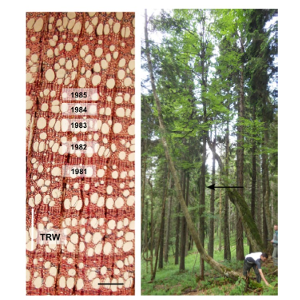 | Sedmáková, D; Sedmák, R; Bošela, M; Ježík, M; Sitko, R; Hlásny, T; Blaženec, M Cross-dating tree-ring series of living European beech by isochronic weather records Journal Article Geochronometria, 43 (1), pp. 48-58, 2016, ISSN: 1897-1695. Abstract | Links | BibTeX @article{Sedmáková2016,
title = {Cross-dating tree-ring series of living European beech by isochronic weather records},
author = {D. Sedmáková and R. Sedmák and M. Bošela and M. Ježík and R. Sitko and T. Hlásny and M. Blaženec},
url = {10.1515/geochr-2015-0030},
doi = {10.1515/geochr-2015-0030},
issn = {1897-1695},
year = {2016},
date = {2016-05-20},
journal = {Geochronometria},
volume = {43},
number = {1},
pages = {48-58},
abstract = {The main objective of the study is to facilitate cross-dating of sensitive tree-ring series from living European beech (Fagus sylvatica L.) trees in the absence of a regional chronology. The main idea lies in the preliminary dating of marker rings or ring patterns visually identified on the wood (before the ring-width measurements), which is independently validated through a moving correlation between a tentative reference chronology and instrumental climate records (after the ring-width measurements). Following the detection of low moving correlations, potentially misdated segments or series are re-examined and a new tentative reference chronology is constructed. The process is repeated as long as a higher correlation with climate is obtainable. The applicability of this method was investigated on three difficult-to-date sets of tree-ring series of beech trees which were growing at temperature-or precipitation-sensitive locations in under-canopy or canopy positions. A good ability of the combined method for the cross-dating was practiced on datasets almost impossible to cross-date by commonly used approaches. Highlighting the actual correlation of ring widths with climate in tree-ring series makes the cross-dating process more independent from human decisions, so the combined cross-dating has the potential to improve the reliability of various dendrochronological studies.},
keywords = {},
pubstate = {published},
tppubtype = {article}
}
The main objective of the study is to facilitate cross-dating of sensitive tree-ring series from living European beech (Fagus sylvatica L.) trees in the absence of a regional chronology. The main idea lies in the preliminary dating of marker rings or ring patterns visually identified on the wood (before the ring-width measurements), which is independently validated through a moving correlation between a tentative reference chronology and instrumental climate records (after the ring-width measurements). Following the detection of low moving correlations, potentially misdated segments or series are re-examined and a new tentative reference chronology is constructed. The process is repeated as long as a higher correlation with climate is obtainable. The applicability of this method was investigated on three difficult-to-date sets of tree-ring series of beech trees which were growing at temperature-or precipitation-sensitive locations in under-canopy or canopy positions. A good ability of the combined method for the cross-dating was practiced on datasets almost impossible to cross-date by commonly used approaches. Highlighting the actual correlation of ring widths with climate in tree-ring series makes the cross-dating process more independent from human decisions, so the combined cross-dating has the potential to improve the reliability of various dendrochronological studies. |
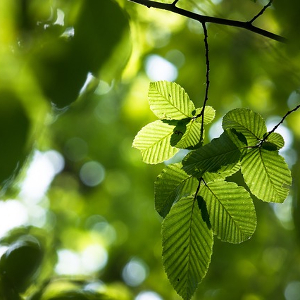 | Ježík, M; Blaženec, M; Kučera, J; Střelcová, K; Ditmarová, Ľ The response of intra-annual stem circumference increase of young European beech provenances to 2012-2014 weather variability Journal Article i-Forest, 9 (6), pp. 960-969, 2016, ISSN: 1971-7458. Abstract | Links | BibTeX @article{Ježík2016,
title = {The response of intra-annual stem circumference increase of young European beech provenances to 2012-2014 weather variability},
author = {M. Ježík and M. Blaženec and J. Kučera and K. Střelcová and Ľ. Ditmarová},
url = {http://www.sisef.it/iforest/contents/?id=ifor1829-009},
doi = {10.3832/ifor1829-009},
issn = {1971-7458},
year = {2016},
date = {2016-01-01},
journal = {i-Forest},
volume = {9},
number = {6},
pages = {960-969},
abstract = {The increasing frequency and severity of extreme weather events, especially droughts, arising from on-going climate changes negatively affect productivity and stability of forest ecosystems. Understanding species responses and suitable ecotypes that are able of adapting to new environmental conditions is increasingly important. The objective of this study was to quantify the relationships between the inter-annual stem circumference increase (SCI) of five European beech (Fagus sylvatica L.) provenances and weather variability during 2012-2014 in a provenance trial located in central Slovakia. SCIs were extracted on daily and weekly scale from hourly data of circumference changes. To detect the main environmental factors influencing SCI seasonal dynamics, intra-seasonal moving correlation functions were calculated. All five provenances responded synchronously to weather conditions, with high correlations among them during the growing season on both daily and weekly scale. The photoperiod exhibited a synchronizing effect on the seasonal peak of SCI as a sign of tree adaptation to long-term seasonal variations in climate. Temperature was the most significant factor influencing SCI dynamics at the beginning of the season. During the summer months, a precipitation deficit, heat waves and the consequently decreased soil water potential significantly affected the SCI of young beech trees, despite the fact that the provenance plot was situated in an area of optimum beech growth. Not only the severity and duration were important but also the timing of drought within a season. Within all seasons, the lowest SCI values were recorded for the provenance from the lowest altitude and the most oceanic climate (northern Germany). A comparison of daily and weekly SCI with first derivatives of growth functions indicated that SCIs were closely related to theoretical incremental processes, especially on a weekly scale. In young beech trees, SCI seemed to represent an appropriate proxy for studying intra-seasonal incremental processes. A newly designed SASB (self adjusting sharp beginning) function fit these processes better than the Gompertz function.},
keywords = {},
pubstate = {published},
tppubtype = {article}
}
The increasing frequency and severity of extreme weather events, especially droughts, arising from on-going climate changes negatively affect productivity and stability of forest ecosystems. Understanding species responses and suitable ecotypes that are able of adapting to new environmental conditions is increasingly important. The objective of this study was to quantify the relationships between the inter-annual stem circumference increase (SCI) of five European beech (Fagus sylvatica L.) provenances and weather variability during 2012-2014 in a provenance trial located in central Slovakia. SCIs were extracted on daily and weekly scale from hourly data of circumference changes. To detect the main environmental factors influencing SCI seasonal dynamics, intra-seasonal moving correlation functions were calculated. All five provenances responded synchronously to weather conditions, with high correlations among them during the growing season on both daily and weekly scale. The photoperiod exhibited a synchronizing effect on the seasonal peak of SCI as a sign of tree adaptation to long-term seasonal variations in climate. Temperature was the most significant factor influencing SCI dynamics at the beginning of the season. During the summer months, a precipitation deficit, heat waves and the consequently decreased soil water potential significantly affected the SCI of young beech trees, despite the fact that the provenance plot was situated in an area of optimum beech growth. Not only the severity and duration were important but also the timing of drought within a season. Within all seasons, the lowest SCI values were recorded for the provenance from the lowest altitude and the most oceanic climate (northern Germany). A comparison of daily and weekly SCI with first derivatives of growth functions indicated that SCIs were closely related to theoretical incremental processes, especially on a weekly scale. In young beech trees, SCI seemed to represent an appropriate proxy for studying intra-seasonal incremental processes. A newly designed SASB (self adjusting sharp beginning) function fit these processes better than the Gompertz function. |
2015
|
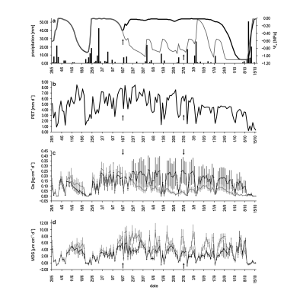 | Ježík, M; Blaženec, M; Letts, M G; Ditmarová, Ľ; Sitková, Z; Střelcová, K Assessing seasonal drought stress response in Norway spruce (Picea abies (L.) Karst.) by monitoring stem circumference and sap flow Journal Article Ecohydrology, 8 (3), pp. 378–386, 2015. Links | BibTeX @article{M.2015b,
title = {Assessing seasonal drought stress response in Norway spruce (\textit{Picea abies} (L.) Karst.) by monitoring stem circumference and sap flow},
author = {M. Ježík and M. Blaženec and M.G. Letts and Ľ. Ditmarová and Z. Sitková and K. Střelcová},
url = {http://onlinelibrary.wiley.com/doi/10.1002/eco.1536/full},
year = {2015},
date = {2015-04-01},
journal = {Ecohydrology},
volume = {8},
number = {3},
pages = {378–386},
keywords = {},
pubstate = {published},
tppubtype = {article}
}
|
![Hodnotenie zdravotného stavu smreka vo vzťahu smreka k náletu podkôrneho hmyzu a k odumieraniu lesa [Evaluation of Norway spruce helath status in relationships with bark beetle outbreak and forest dying]](https://ife.sk/wp-content/uploads/2016/10/IFE_blazenec_02.png) | Jakuš, R; Cudlín, P; Slivinský, J; Mezei, P; Majdák, A; Blaženec, M Hodnotenie zdravotného stavu smreka vo vzťahu smreka k náletu podkôrneho hmyzu a k odumieraniu lesa [Evaluation of Norway spruce helath status in relationships with bark beetle outbreak and forest dying] Book Ústav ekológie lesa, Slovenská akadémia vied, Zvolen, 2015, ISBN: 978-80-89408-22-1. Links | BibTeX @book{Jakuš2015,
title = {Hodnotenie zdravotného stavu smreka vo vzťahu smreka k náletu podkôrneho hmyzu a k odumieraniu lesa [Evaluation of Norway spruce helath status in relationships with bark beetle outbreak and forest dying]},
author = {R. Jakuš and P. Cudlín and J. Slivinský and P. Mezei and A. Majdák and M. Blaženec},
url = {https://www.researchgate.net/publication/280014410_Hodnotenie_zdravotneho_stavu_smreka_vo_vztahu_k_naletu_podkorneho_hmyzu_a_k_odumieraniu_lesa},
isbn = {978-80-89408-22-1},
year = {2015},
date = {2015-01-01},
booktitle = {Prognosticko-informačné systémy pre zvýšenie efektívnosti manažmentu lesa},
publisher = {Ústav ekológie lesa, Slovenská akadémia vied},
address = {Zvolen},
keywords = {},
pubstate = {published},
tppubtype = {book}
}
|
![Princípy ochrany dospelých smrekových porastov pred podkôrnym hmyzom [Conservation principles of mature Norway spruce trees attacked by bark beetles]](https://ife.sk/wp-content/uploads/2016/10/IFE_blazenec_03.png) | Jakuš, R; Blaženec, M; Gurtsev, A I; Holuša, J; Hroššo, B; Křenová, Z; Longauerová, V; Lukášová, K; Majdák, A; Mezei, P; Slivinský, J Princípy ochrany dospelých smrekových porastov pred podkôrnym hmyzom [Conservation principles of mature Norway spruce trees attacked by bark beetles] Book Ústav ekológie lesa, Slovenská akadémia vied, Zvolen, 2015, ISBN: 978-80-89408-21-4. Links | BibTeX @book{Jakuš2015b,
title = {Princípy ochrany dospelých smrekových porastov pred podkôrnym hmyzom [Conservation principles of mature Norway spruce trees attacked by bark beetles]},
author = {R. Jakuš and M. Blaženec and A.I. Gurtsev and J. Holuša and B. Hroššo and Z. Křenová and V. Longauerová and K. Lukášová and A. Majdák and P. Mezei and J. Slivinský},
editor = {R. Jakuš and M. Blaženec},
url = {https://www.researchgate.net/publication/280883448_Principy_ochrany_dospelych_smrekovych_porastov_pred_podkornym_hmyzom},
isbn = {978-80-89408-21-4},
year = {2015},
date = {2015-01-01},
booktitle = {Prognosticko-informačné systémy pre zvýšenie efektívnosti manažmentu lesa},
publisher = {Ústav ekológie lesa, Slovenská akadémia vied},
address = {Zvolen},
keywords = {},
pubstate = {published},
tppubtype = {book}
}
|
2014
|
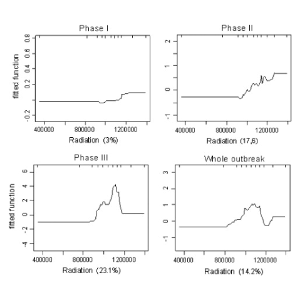 | Mezei, P; Grodzki, W; Blaženec, M; Škvarenina, J; Brandýsová, V; Jakuš, R Host and site factors affecting tree mortality caused by the spruce bark beetle (Ips typographus) in mountainous conditions Journal Article Forest Ecology and Management, 331 , pp. 196–207, 2014. Links | BibTeX @article{P.2014b,
title = {Host and site factors affecting tree mortality caused by the spruce bark beetle (\textit{Ips typographus}) in mountainous conditions},
author = {P. Mezei and W. Grodzki and M. Blaženec and J. Škvarenina and V. Brandýsová and R. Jakuš},
url = {http://www.sciencedirect.com/science/article/pii/S0378112714004691},
year = {2014},
date = {2014-11-01},
journal = {Forest Ecology and Management},
volume = {331},
pages = {196–207},
keywords = {},
pubstate = {published},
tppubtype = {article}
}
|
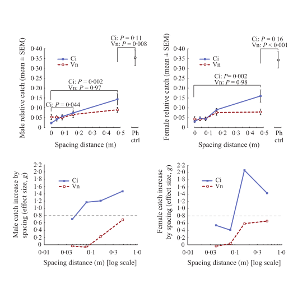 | Binyameen, M; Jankuvová, J; Blaženec, M; Jakuš, R; Song, L; Schlyter, F; Andersson, M N Co-localization of insect olfactory sensory cells improves the discrimination of closely separated odour sources Journal Article Functional Ecology, 28 (5), pp. 1216–1223, 2014. Links | BibTeX @article{M.2014,
title = {Co-localization of insect olfactory sensory cells improves the discrimination of closely separated odour sources},
author = {M. Binyameen and J. Jankuvová and M. Blaženec and R. Jakuš and L. Song and F. Schlyter and M.N. Andersson},
url = {http://onlinelibrary.wiley.com/doi/10.1111/1365-2435.12252/abstract},
year = {2014},
date = {2014-03-03},
journal = {Functional Ecology},
volume = {28},
number = {5},
pages = {1216–1223},
keywords = {},
pubstate = {published},
tppubtype = {article}
}
|
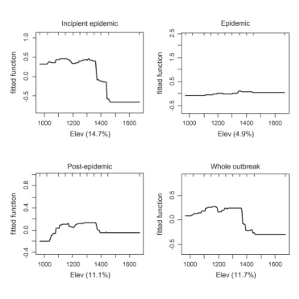 | Mezei, P; Grodzki, W; Blaženec, M; Jakuš, R Factors influencing the wind-bark beetles’ disturbance system in the course of an Ips typographus outbreak in the Tatra Mountains Journal Article Forest Ecology and Management, 312 , pp. 67–77, 2014. Links | BibTeX @article{P.2014b,
title = {Factors influencing the wind-bark beetles’ disturbance system in the course of an \textit{Ips typographus} outbreak in the Tatra Mountains},
author = {P. Mezei and W. Grodzki and M. Blaženec and R. Jakuš},
url = {http://www.sciencedirect.com/science/article/pii/S0378112713006877},
year = {2014},
date = {2014-01-01},
journal = {Forest Ecology and Management},
volume = {312},
pages = {67–77},
keywords = {},
pubstate = {published},
tppubtype = {article}
}
|
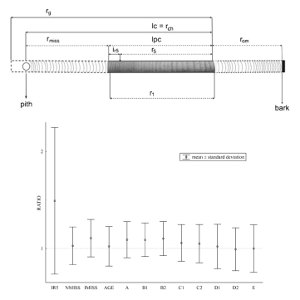 | Sedmák, R; Sedmáková, D; Bošeľa, M; Marušák, R; Ježík, M; Murga, V; Blaženec, M Age estimation of Norway spruce using incomplete increment cores: testing new and improved methods Journal Article Dendrochronologia, 32 (4), pp. 327–335, 2014. Links | BibTeX @article{R.2014b,
title = {Age estimation of Norway spruce using incomplete increment cores: testing new and improved methods},
author = {R. Sedmák and D. Sedmáková and M. Bošeľa and R. Marušák and M. Ježík and V. Murga and M. Blaženec},
url = {http://www.sciencedirect.com/science/article/pii/S1125786514000599},
year = {2014},
date = {2014-01-01},
journal = {Dendrochronologia},
volume = {32},
number = {4},
pages = {327–335},
keywords = {},
pubstate = {published},
tppubtype = {article}
}
|
2012
|
 | Mezei, P; Jakuš, R; Blaženec, M; Belánová, S; Šmídt, J The relationship between potential solar radiation and spruce bark beetle catches in pheromone traps Journal Article Annals of Forest Research, 55 (2), pp. 243-252, 2012, ISSN: 18448135. Abstract | BibTeX @article{Mezei2012,
title = {The relationship between potential solar radiation and spruce bark beetle catches in pheromone traps},
author = {P. Mezei and R. Jakuš and M. Blaženec and S. Belánová and J. Šmídt},
issn = {18448135},
year = {2012},
date = {2012-01-01},
journal = {Annals of Forest Research},
volume = {55},
number = {2},
pages = {243-252},
abstract = {We analysed the relationship between the amount of potential solar radiation and spruce bark beetle Ips typographus(L.) catches in pheromone traps in an unmanaged nature reserve in the Carpathians (middle Slovakia region), from 2006 through 2009. This relationship was analysed under outbreak conditions. The number of traps varied in different years from 70 to 92. The traps were installed in spruce-forest-dominated stands affected by a windstorm in 2004. A GPS device was used to mark the position of the pheromone traps. The potential solar radiation was calculated with GIS tools for three different time periods in each year: with entire year, for main flight season of the spruce bark beetle and the spring swarming period. The relationship between the amount of potential solar radiation and the spruce bark beetle catches was statistically significant for each year and each time period except for the spring swarming in 2007, when the pheromone traps were not set up on time.},
keywords = {},
pubstate = {published},
tppubtype = {article}
}
We analysed the relationship between the amount of potential solar radiation and spruce bark beetle Ips typographus(L.) catches in pheromone traps in an unmanaged nature reserve in the Carpathians (middle Slovakia region), from 2006 through 2009. This relationship was analysed under outbreak conditions. The number of traps varied in different years from 70 to 92. The traps were installed in spruce-forest-dominated stands affected by a windstorm in 2004. A GPS device was used to mark the position of the pheromone traps. The potential solar radiation was calculated with GIS tools for three different time periods in each year: with entire year, for main flight season of the spruce bark beetle and the spring swarming period. The relationship between the amount of potential solar radiation and the spruce bark beetle catches was statistically significant for each year and each time period except for the spring swarming in 2007, when the pheromone traps were not set up on time. |
2011
|
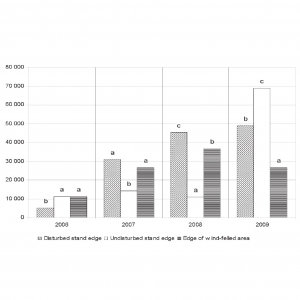 | Mezei, P; Jakuš, R; Blaženec, M; Belánová, S; Šmídt, J Population dynamics of spruce bark beetle in a nature reserve in relation to stand edges conditions Journal Article Folia Oecologica, 38 (1), pp. 73-79, 2011, ISSN: 13365266. Abstract | BibTeX @article{Mezei2011,
title = {Population dynamics of spruce bark beetle in a nature reserve in relation to stand edges conditions},
author = {P. Mezei and R. Jakuš and M. Blaženec and S. Belánová and J. Šmídt},
issn = {13365266},
year = {2011},
date = {2011-01-01},
journal = {Folia Oecologica},
volume = {38},
number = {1},
pages = {73-79},
abstract = {Over the period 2006–2009 spruce bark beetle (Ips typographus [L.]) population was monitored
after two windstorm events in a nature reserve in Slovak Ore Mountains. The monitoring was carried out with pheromone traps in three different forest edges: 1) edge of wind-felled trees area, 2)
disturbed stand edge and 3) undisturbed stand edge. The one-way ANOVAconfirmed statistically
significant differences among stand edges in each year and a post-hoc test was applied. In first
two years after the primary disturbance the most attractive for spruce bark beetle was the edge of
wind-felled trees area. After two years from the primary disturbance the most attractive became
the disturbed stand edge. The undisturbed stand edge showed a similar attractivity for spruce bark
beetles almost over the whole monitoring period.},
keywords = {},
pubstate = {published},
tppubtype = {article}
}
Over the period 2006–2009 spruce bark beetle (Ips typographus [L.]) population was monitored
after two windstorm events in a nature reserve in Slovak Ore Mountains. The monitoring was carried out with pheromone traps in three different forest edges: 1) edge of wind-felled trees area, 2)
disturbed stand edge and 3) undisturbed stand edge. The one-way ANOVAconfirmed statistically
significant differences among stand edges in each year and a post-hoc test was applied. In first
two years after the primary disturbance the most attractive for spruce bark beetle was the edge of
wind-felled trees area. After two years from the primary disturbance the most attractive became
the disturbed stand edge. The undisturbed stand edge showed a similar attractivity for spruce bark
beetles almost over the whole monitoring period. |
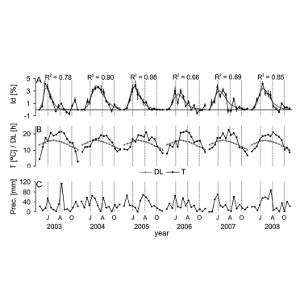 | Ježík, M; Blaženec, M; Střelcová, K; Ditmarová, Ľ The impact of the 2003-2008 weather variability on intra-annual stem diameter changes of beech trees at a submontane site in central Slovakia Journal Article Dendrochronologia, 29 , pp. 227-235, 2011. BibTeX @article{Ježík2011,
title = {The impact of the 2003-2008 weather variability on intra-annual stem diameter changes of beech trees at a submontane site in central Slovakia},
author = {M. Ježík and M. Blaženec and K. Střelcová and Ľ. Ditmarová},
year = {2011},
date = {2011-01-01},
journal = {Dendrochronologia},
volume = {29},
pages = {227-235},
keywords = {},
pubstate = {published},
tppubtype = {article}
}
|
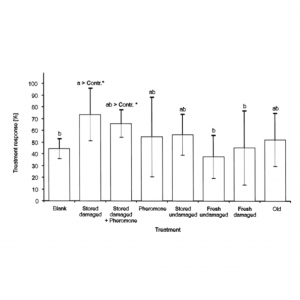 | Jakuš, R; Blaženec, M Response of walking spruce bark beetles Ips typographus to host odours Journal Article Folia Oecologica, 38 (1), pp. 38-45, 2011, ISSN: 1336-5266. Abstract | Links | BibTeX @article{Jakuš2011,
title = {Response of walking spruce bark beetles Ips typographus to host odours},
author = {R. Jakuš and M. Blaženec},
url = {http://ife.sk/wp-content/uploads/2016/10/5.pdf},
issn = {1336-5266},
year = {2011},
date = {2011-01-01},
journal = {Folia Oecologica},
volume = {38},
number = {1},
pages = {38-45},
abstract = {A two-choice walking bioassay olfactometer was used to asses the response of walking Ips typographus (L.) towards the odours from logs of Norway spruce (Picea abies [L.] Karst.) subjected to various treatments. The odour coming from fresh log from standing, unstressed trunk was unattractive or slightly repellent to males over clean air in bioassay. The same odour was neutral or slightly attractive to females. Storing of a log for one month led to increased attractiveness to both sexes. The odour from log after bark beetle breeding was slightly more attractive to both sexes over clean air, excepting very low level of source contact in males. Results on overall attraction are more unclear for females. The level of source contact was the main difference between the males and females. The females manifested higher levels of source contact than males.},
keywords = {},
pubstate = {published},
tppubtype = {article}
}
A two-choice walking bioassay olfactometer was used to asses the response of walking Ips typographus (L.) towards the odours from logs of Norway spruce (Picea abies [L.] Karst.) subjected to various treatments. The odour coming from fresh log from standing, unstressed trunk was unattractive or slightly repellent to males over clean air in bioassay. The same odour was neutral or slightly attractive to females. Storing of a log for one month led to increased attractiveness to both sexes. The odour from log after bark beetle breeding was slightly more attractive to both sexes over clean air, excepting very low level of source contact in males. Results on overall attraction are more unclear for females. The level of source contact was the main difference between the males and females. The females manifested higher levels of source contact than males. |
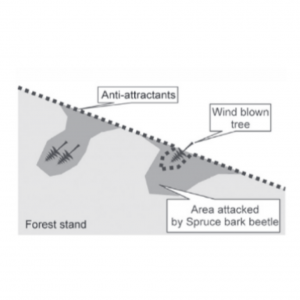 | Jakuš, R; Blaženec, M; Vojtěch, O Use of anti-attractants in specific conditions of protected areas Journal Article Folia Oecologica, 38 (1), pp. 46-51, 2011, ISSN: 1336-5266. Abstract | Links | BibTeX @article{Jakuš2011b,
title = {Use of anti-attractants in specific conditions of protected areas},
author = {R. Jakuš and M. Blaženec and O. Vojtěch},
url = {http://ife.sk/wp-content/uploads/2016/10/6.pdf},
issn = {1336-5266},
year = {2011},
date = {2011-01-01},
journal = {Folia Oecologica},
volume = {38},
number = {1},
pages = {46-51},
abstract = {Tests for protection of spruce forest stands against spruce bark beetle (Ips typographus) by using anti-attractants were performed in specific conditions of protected areas in which standard sanitary cutting is not allowed. The experiments have shown that application of anti-attractants in a no-cutting zone can significantly reduce bark beetle attacks on the standing trees. In case when the trees at stand edges are not damaged by wind, there is possible to reduce the tree mortality by up to 73%, even in case of large bark beetle populations and even in living green trees growing immediately next to trees attacked by spruce bark beetle. On the other hand, anti-attractants are ineffective at stand edge segments either damaged by freshly wind-thrown or broken trees or wedged with wind-thrown areas, as it was shown in semi-application tests in the NP šumava.},
keywords = {},
pubstate = {published},
tppubtype = {article}
}
Tests for protection of spruce forest stands against spruce bark beetle (Ips typographus) by using anti-attractants were performed in specific conditions of protected areas in which standard sanitary cutting is not allowed. The experiments have shown that application of anti-attractants in a no-cutting zone can significantly reduce bark beetle attacks on the standing trees. In case when the trees at stand edges are not damaged by wind, there is possible to reduce the tree mortality by up to 73%, even in case of large bark beetle populations and even in living green trees growing immediately next to trees attacked by spruce bark beetle. On the other hand, anti-attractants are ineffective at stand edge segments either damaged by freshly wind-thrown or broken trees or wedged with wind-thrown areas, as it was shown in semi-application tests in the NP šumava. |
2010
|
 | Kmeť, J; Ditmarová, Ľ; Priwitzer, T; Kurjak, D; Baláž, P; Blaženec, M Physiological limits – a possible cause of spruce decline Journal Article Beskydy, 3 (1), pp. 55-64, 2010, ISSN: 1803-2451. BibTeX @article{Kmeť2010,
title = {Physiological limits – a possible cause of spruce decline},
author = {J. Kmeť and Ľ. Ditmarová and T. Priwitzer and D. Kurjak and P. Baláž and M. Blaženec},
issn = {1803-2451},
year = {2010},
date = {2010-01-01},
journal = {Beskydy},
volume = {3},
number = {1},
pages = {55-64},
keywords = {},
pubstate = {published},
tppubtype = {article}
}
|









![TANABBO II model pro hodnocení rizika napadení lesních porostů lýkožroutem smrkovým Ips typographus (L.) [Coleoptera: Curculionidae]](http://ife.sk/wp-content/uploads/2020/09/jakus_2007.png)



![Hodnotenie zdravotného stavu smreka vo vzťahu smreka k náletu podkôrneho hmyzu a k odumieraniu lesa [Evaluation of Norway spruce helath status in relationships with bark beetle outbreak and forest dying]](https://ife.sk/wp-content/uploads/2016/10/IFE_blazenec_02.png)
![Princípy ochrany dospelých smrekových porastov pred podkôrnym hmyzom [Conservation principles of mature Norway spruce trees attacked by bark beetles]](https://ife.sk/wp-content/uploads/2016/10/IFE_blazenec_03.png)










